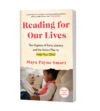By Maya Payne Smart
The idea of reading to children daily is deeply entrenched in American culture, even if the practice hasn’t completely taken hold. Books advising parents on creating family reading routines, and recommending what to read to kids when, have flourished since the 1930s. Raise-a-reader stories are standard features of parenting magazines and blogs. Schools, teachers, and community organizations all tout the benefits of reading to kids. My local grocery store chain even runs a book drive and encourages parents to pledge to read to their children several times a week.
But there’s much less discussion of what exactly to do during storytime beyond turning the pages, reading with feeling, and keeping things fun. The link between printed words on the page, a parent’s spoken recitation of them, and the child’s path to literacy is unclear. In fact, experts say that typical parent read-alouds focus on the story and illustrations. And small children more often than not imagine that we’re deriving the story we’re reading aloud (down to its specific wording) from the engaging pictures, not the squiggles next to them.
Check out the four articles below for insights into the science of brain development, the research on fostering literacy, and the little touches and tweaks that can turbocharge story time.
GUARANTEED WAYS TO ENGAGE KIDS WITH FAMILY READ-ALOUDS
From the pediatrician’s office to parenting magazine columns, numerous voices tout the benefits of regularly reading aloud to young children for language development. But storytime quantity is just part of the equation. How parents read to kids (not just how often) matters too, and I don’t mean the pacing and performance qualities of reading aloud. No matter how thrilling the story or a parent’s delivery, a verbatim front-to-back reading of a book leaves out critical brain-building, literacy-boosting power. (Read more.)
BEST REASONS TO READ ALOUD TO BABIES
While extolling the virtues of reading together for bolstering character and resilience, plus remedying the ills of digital distraction and social fragmentation, it’s easy to skip right over its greatest power—seeding early literacy. Read on for a few science-backed insights into boosting brain capacity, stimulating language development, and spurring vocabulary growth by sharing reading from day one. (Read more.)
READING ALOUD TIPS TO GET YOUR CHILD KINDERGARTEN READY
When reading together, we tend to do little to raise kids’ awareness of how books work, how print conveys meaning, and what letters and words really are. These are vital lessons, because before a child can read print, they must notice it. Fortunately, it takes just a small course correction to maximize story time and help little ones bridge from listening into literacy. Parents or caregivers have thousands of opportunities to give mini-lessons on print concepts during storybook reading. It’s just a question of knowing what to point out to help forge a conscious connection between what they’re hearing and what you’re reading. (Read more.)
DON’T MAKE STORY TIME A SNOOZE. TRY THESE 6 READ-ALOUD STYLES INSTEAD.
The term “read aloud” is deceptively simple—so self-evident in meaning that it seldom inspires discussion beyond admonitions to read with feeling and do it daily. But three decades of reading research reveals that there’s much more than reading aloud going on during the best story times. And, in fact, conversation that veers off the page may be as literacy-rich as the words in print. (Read more.)


